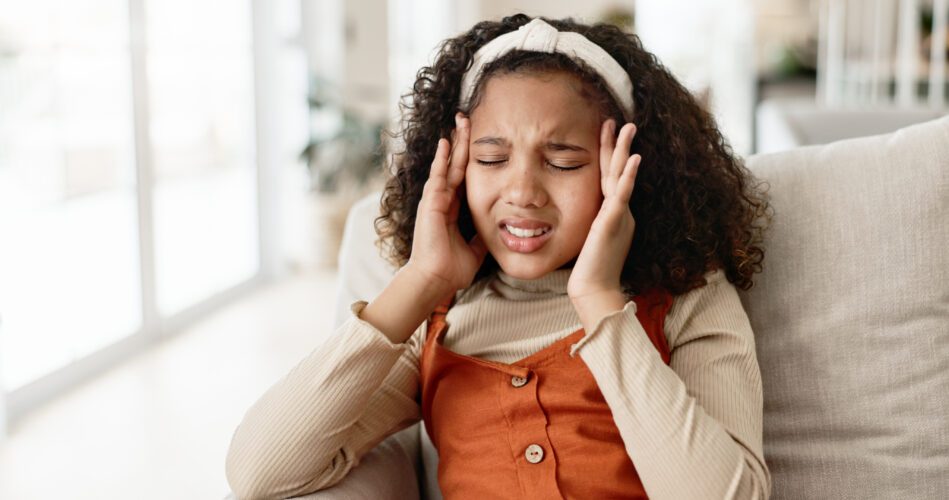Up to 10% of children and teens suffer from migraine headaches, but only a few drugs are known to be safe, effective and have few side effects.
A child suffering from migraines will certainly be offered medicine. But with so few drugs being tested for safety on children, what can a parent give a child that won’t have nasty side effects or, worse, long-term effects?
The good news is there has been a spate of research on the 3 most common drugs offered to children with migraines: ibuprofen, acetaminophen and a class of drugs called triptans.
Migraine headaches are a debilitating condition that not only presents as disturbing headache pain, but often comes accompanied with nausea, vomiting, and sensitivity to light and sound. A migraine can last hours or even days and frequently results in missed work days for parents, missed school and social activities, and a lower quality of life that is comparable to people with other chronic diseases such as diabetes.
Parental concerns regarding treatment can be amplified when physicians are uncertain of the best treatments to pursue. And when it comes to selective migraine medications, “it’s understandable that parents often have immediate concern over possible side effects, as most of these are largely being used off-label,” says Dr. Lawrence Richer, a researcher at Department of Pediatrics, Division of Neurology, at the University of Alberta, Canada.
What Are Triptans?
For example, triptans, a class of migraine medication, are being prescribed to children and adolescents, yet, “only a couple of triptan medications have approval for use under the age of 18 years,” he adds. Brand names for triptans include: Maxalt (rizatriptan), Imitrex (sumatriptan), Axert (almotriptan), Relpax (eletriptan), Amerge (naratriptan), and Zomig (zolmitriptan)
Closing the Gap in Med Research for Children with Migraine Attack
The FDA reports that many drugs prescribed for children have not been tested in children. “Thankfully, many of the triptan companies have tried to close the gap in this regard, which is not necessarily the case with so many other medications,” says Dr. Richer. Due to legislative changes, the past 5 years have presented more research on children and adolescents than the previous 30 years combined, with more triptans being added to the FDA pediatric approved list.
In regard to the efficacy and safety of migraine medications in children and adolescents, Richer and colleagues published a Cochrane systematic review in April 2016 which provides new insights that may help inform parental choices. The review looked at 27 randomized controlled trials in children and adolescents ranging between 8.2-14.7 years, to establish the effectiveness of acetaminophen, ibuprofen and other NSAIDs (non-steroidal anti-inflammatory drugs), and triptans, compared to placebo.
The goals for treating acute migraine, which is not to be mistaken for tension-type headaches, is to relieve the patient’s pain in 2 hours so they can return to normal functioning. The primary outcome of this review was absence of pain 2 hours post treatment, before the use of any additional or rescue medication, with the secondary outcome being headache relief.
“Something that was reassuring about our research, at least in the duration of the studies assessed, was that there were no serious adverse events reported.”
—Dr. Lawrence Richer
The results of the review showed that acetaminophen was not effective, while both ibuprofen and triptans were found to be effective treatments for migraine relief. In clinical practice, the research presents ibuprofen as the recommended starting point. “However, there may be situations where ibuprofen is not enough. Therefore, faced with no other choices, triptans are reasonable medications to consider,” says Dr. Richer.
Triptans accounted for 85% of the data reviewed, and included a review of Maxalt and Imitrex in children and adolescents. Additionally, Axert, Relpax, Amerge and Zomig were reviewed in adolescents. Compared to placebo, triptans overall were superior for achieving complete freedom from pain 2 hours post treatment.
“Something that was reassuring about our research, at least in the duration of the studies assessed, was that there were no serious adverse events reported,” says Dr. Richer.
Ibuprofen Shows No Side Effects
Ibuprofen showed no side effects, while for triptans, the efficacy of the medications is something that does need to be counterbalanced by possible (non-serious) side effects including “fatigue, dizziness, asthenia, dry mouth, and nausea or vomiting with oral preparations, and taste disturbance, nasal symptoms, and nausea with intranasal preparation,” the review reports.
Researchers generally agree that the side effects of triptan class medications are considered low and comparable between medication and placebo.
“I’ve found it useful to be able to tell parents that we’ve looked at every study ever done and there have been no serious adverse events,” according to Richer. “They were all transient, minor side effects. And what isn’t in the paper, but what I know, is that these medications are being used off-label relatively frequently, and again, there are no serious adverse side effects being reported.”
Similar results for side effects have been reported in other studies. Published in the journal Headache in January, another systematic review reports only minor side effects at the following observed percentage rates: “nausea 7%, dizziness 3%, muscle tightness 3%, chest discomfort 3%.”
A randomized controlled trial, published in Headache last year, in subjects between the age of 12-17 years, showed the following percentages: “neck spasm/tension 7%; drowsiness 5%; throat tightness 5%; jaw tightness 3%; dizziness 3%; shoulder tightness 2%; and nausea 2%.”
This research is important for both parents and physicians alike in making more informed choices about migraine treatment options. Certainly minor side effects aren’t to be ignored and the pros and cons of selective medications should be discussed with a physician or specialist
Still, “it’s encouraging to see that we can base our advice on the evidence on medication choices now, more than in the past, so that at least it helps parents weigh up the pros and cons more effectively,” adds Richer.






